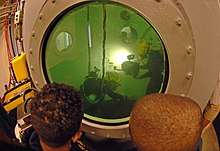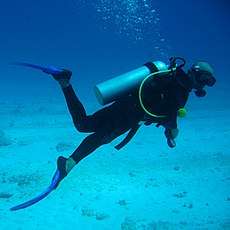Diver training
_Detachment_5%2C_based_in_Pearl_Harbor%2C_Hawaii%2C_explains_the_Mk_20_full_face_mask_to_Seychelles_Coast.jpg)
Diver training is the set of processes through which a person learns the necessary and desirable skills to safely dive underwater within the scope of the training standard relevant to the specific training programme. Most diver training follows procedures and schedules laid down in the associated training standard, in a formal training programme, and includes relevant foundational knowledge of the underlying theory, including some basic physics, physiology and environmental information, practical skills training in the selection and safe use of the associated equipment in the specified underwater environment, and assessment of the required skills and knowledge deemed necessary by the certification agency to allow the newly certified diver to dive within the specified range of conditions at an acceptable level of risk.
Work skills specific to the underwater environment may be included in diver trailing programmes, but are also often provided independently, either as job training for a specific operation, or as generic training by specialists in the fields.
Diving theory
_2%2C_explains_the_effects_of_pressure_on_the_inner.jpg)
_1%2C_teaches_a_class_on_diving_related_casualty_care_to_Iraqi_navy_members_at_the_Iraqi_navy_school.jpg)
Diving skills

Underwater work skills
_2%2C_instructs_a_Barbados_Coast_Guard_diver_on_the_proper_way_to_use_a_hydraulic_grinder_underwater.jpg)
Skill assessment

Professional divers
Professional divers are generally trained firstly to dive safely as a member of a dive team, and secondly in underwater work skills specific to their employment. Registration as a professional diver does not necessarily imply competence in any specific work skills other than those commonly required by the majority of professional diving work.
Commercial divers
Military divers
Public safety divers

Depending on the jurisdiction, public safety divers may be required to be registered as commercial divers, or may be trained independently by specialists, or may be initially trained as recreational divers, then given additional specialist training.[1][2]
In addition to basic diving skills training, public safety divers require specialized training for recognizing hazards, conducting risk assessments, search procedures, diving in zero visibility, using full-face masks with communication systems, and recovering evidence that is admissible in court. Some of the water they are required to dive in is contaminated, and they may be required to wear vulcanized drysuits, with diving helmets sealed to the suit, and utilize surface supplied air. At times, the decontamination process that takes place out of the water can be longer than the dive time.[2]
Scientific divers
Training standards
In some cases national training standards and codes of practice will apply to professional diver training, assessment and registration, for example:
- Australia: Australian Diver Accreditation Scheme (ADAS)
- Canada: Diver Certification Board of Canada (DCBC)
- Norway: Petroleum Safety Authority Norway (PSA)
- South Africa: Department of Labour (South Africa) (DoL)
- United Kingdom: Health and Safety Executive (HSE)
International equivalence
The International Diving Regulators and certifiers Forum[3] (IDRF) is a group of representatives of countries with national training standards for professional divers, who work together towards mutual recognition of diver registration and to identify and implement good practice in diver training and assessment.[4] Members of the IDRF include ADAS (Australia), DCBC (Canada), HSE (UK), PSA (Norway), and the Secretariat General to the Sea Progress Committee (France).
Recreational divers
Recreational diver training is the process of developing knowledge and understanding of the basic principles, and the skills and procedures for the use of scuba equipment so that the diver is able to dive for recreational purposes with acceptable risk using the type of equipment and in similar conditions to those experienced during training.
Recreational scuba
Not only is the underwater environment hazardous but the diving equipment itself can be dangerous. There are problems that divers must learn to avoid and manage when they do occur. Divers need repeated practice and a gradual increase in challenge to develop and internalise the skills needed to control the equipment, to respond effectively if they encounter difficulties, and to build confidence in their equipment and themselves. Diver practical training starts with simple but essential procedures, and builds on them until complex procedures can be managed effectively. This may be broken up into several short training programmes, with certification issued for each stage,[5] or combined into a few more substantial programmes with certification issued when all the skills have been mastered.[6][7]
Many diver training organizations exist, throughout the world, offering diver training leading to certification: the issuing of a "Diving Certification Card," also known as a "C-card," or qualification card. This diving certification model originated at Scripps Institution of Oceanography in 1952 after two divers died while using university-owned equipment and the SIO instituted a system where a card was issued after training as evidence of competence.[8][9] Diving instructors affiliated to a diving certification agency may work independently or through a university, a dive club, a dive school or a dive shop. They will offer courses that should meet, or exceed, the standards of the certification organization that will certify the divers attending the course. The International Organization for Standardization has approved six recreational diving standards that may be implemented worldwide, and some of the standards developed by the (United States) RSTC are consistent with the applicable ISO Standards:[10]
The initial open water training for a person who is medically fit to dive and a reasonably competent swimmer is relatively short. Many dive shops in popular holiday locations offer courses intended to teach a novice to dive in a few days, which can be combined with diving on the vacation.[5] Other instructors and dive schools will provide more thorough training, which generally takes longer.[7] Dive operators, dive shops, and cylinder filling stations may refuse to allow uncertified people to dive with them, hire diving equipment or have their diving cylinders filled. This may be an agency standard, company policy, or specified by legislation.[11]
International standards equivalence
The International Organization for Standardization has approved six recreational diving standards that may be implemented worldwide (January 2007).
The listed standards developed by the (United States) RSTC are consistent with the applicable ISO Standards:[10]
| (USA) RSTC Standard | ISO Standard | Alternative ISO Title |
|---|---|---|
| Introductory Scuba Experience | No equivalent | |
| No equivalent | Level One Diver [12] | Supervised Diver |
| Open Water Diver | Level Two Diver[12] | Autonomous Diver |
| Dive Supervisor | Level Three Diver[12] | Dive Leader |
| Assistant Instructor | Level 1 Instructor[12] | |
| Scuba Instructor | Level 2 Instructor[12] | |
| Instructor Trainer | No equivalent | |
| No equivalent | Service Provider[12] |
Technical diving

Technical diving requires specialised equipment and training. There are many technical training organisations: see the Technical Diving section in the list of diver certification organizations. Technical Diving International (TDI), Global Underwater Explorers (GUE), Professional Scuba Association International (PSAI), International Association of Nitrox and Technical Divers (IANTD) and National Association of Underwater Instructors (NAUI) were popular as of 2009. Recent entries into the market include Unified Team Diving (UTD), InnerSpace Explorers (ISE) and Diving Science and Technology (DSAT), the technical arm of Professional Association of Diving Instructors (PADI). The Scuba Schools International (SSI) Technical Diving Program (TechXR – Technical eXtended Range) was launched in 2005.[13]
British Sub-Aqua Club (BSAC) training has always had a technical element to its higher qualifications, however, it has recently begun to introduce more technical level Skill Development Courses into all its training schemes by introducing technical awareness into its lowest level qualification of Ocean Diver, for example, and nitrox training will become mandatory. It has also recently introduced trimix qualifications and continues to develop closed circuit training.
Freediving
In most jurisdictions, no certification is required for freediving, and the equipment is sold freely over the counter with no questions asked of the purhaser's competence to use it. Most freedivers learn the skills from practice, often with some coaching from a friend, and sometimes attend a formal training programme presented by a qualified and registered instructor, with assessment and certification of competence as the target.
References
- ↑ Phillips, Mark (November 2015). "Public Safety Diving and OSHA, Are We Exempt? Final Answer" (PDF). PS Diver Magazine. Mark Phillips. Retrieved 7 June 2016.
- 1 2 Robinson, Blades (2 January 2011). "What is public safety diving". Retrieved 2 June 2012.
- ↑ "Minutes of the EDTC meeting held on Sept 10th 2010 in Prague, Czech Republic". The European Diving Technology Committee. 2010. Retrieved 13 September 2013.
- ↑ staff (2017). Closed Bell Diver Training V1.0 (Report). International Diving Regulators and Certifiers Forum (IDRCF).
- 1 2 PADI (2010). PADI Instructor Manual. Rancho Santa Margarita, CA: USA: PADI.
- ↑ "C.M.A.S. Diver Training Program" (PDF). Confédération Mondiale des Activités Subaquatiques. 2005-01-18. pp. 4, 6. Archived from the original (PDF) on 2011-07-19. Retrieved 2009-09-23. 1 T 10 and 1 P 6 cover rescue.
- 1 2 Staff (2011). "1.2 Training Philosophy". General Training Standards, Policies, and Procedures. Version 6.2. Global Underwater Explorers.
- ↑ Manual for Diving Safety (PDF) (11th ed.). San Diego: Scripps Institution of Oceanography, University of California. 2005. p. 2. Archived from the original (PDF) on 2012-04-26.
- ↑ "Scripps Institution of Oceanography Diver Certification". SIO. 2011. Archived from the original on 2012-04-26. Retrieved 2011-12-13.
- 1 2 Staff, WRSTC (2013) ISO approves 6 Diving Standards "Archived copy". Archived from the original on 2013-10-03. Retrieved 2013-09-28. retrieved 28 September 2013
- ↑ "Recreational diving Act, 1979" (in Hebrew). Knesset. 1979. Retrieved 16 November 2016 – via WikiSource.
- 1 2 3 4 5 6 Staff. "Standards for Training Organisations/System". EUF Certification International. Retrieved 28 September 2013.
- ↑ "SSI TechXR - Technical diving program". Scuba Schools International. Retrieved 2009-06-22.


.jpg)